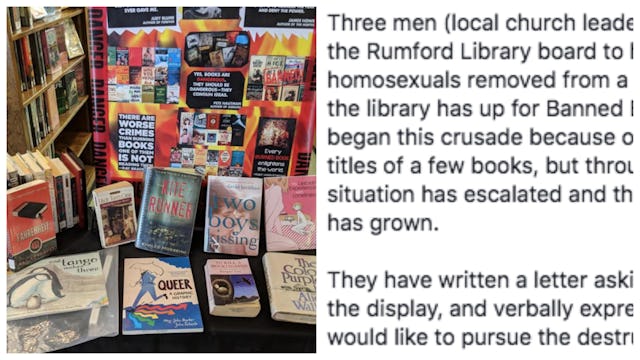Church Members Try To Ban Books At The Local Library -- From The 'Banned Books' Display

Banning ‘Banned Books?’ This one’s a head scratcher…
Since the beginning of time — ok, certainly since the beginning of books — people have tried to ban what others consume. Whether for religious, political, or stereotypical “reasons,” certain groups have tried to control (do away with) certain types of books. So, when a few church leaders in Maine made headlines trying to ban books from the local libraries “banned books” event, most everyone of a composed mindset had to LOL.
Katrina Ray Saulis posted the unusual saga on Facebook, giving people some perspective on the plight of ‘Banned Books Week’ — an annual event put on by the American Library Association across the country to display the “most challenged books each year across the country.” The event is meant to bring awareness to books that groups have tried banning in libraries, schools, and other public places. This year the Rumford Library in Maine received an ironic request — to ban books on the banned book display.
“Three men (local church leaders) are petitioning the Rumford Library board to have all books with homosexuals removed from a banned book display the library has up for Banned Books Week,” Saulis wrote. “They began this crusade because of the cover art and titles of a few books, but throughout this week the situation has escalated and their list of grievances has grown.”
Apparently in addition to requesting the display be removed, one of the dudes said he’d “like to pursue the destruction of all books regarding homosexuality in the library.” Some of the books in question on display include The Color Purple, Two Boys Kissing, My Lesbian Experience with Loneliness, and Uncle Tom’s Cabin.
“A number of other books in the display were promoting homosexuality,” the church members said in a letter to the library. “The library should not be promoting a far left political view that that sees homosexuality as acceptable.” They went on to say, “We believe many in this community would be concerned about the book that had the two naked women on the cover as being immodest and inappropriate in a public setting.”
For the record, the American public – parents, library members, religious affiliates – can object to books that they think are inappropriate for readers, especially youth. To combat this, beginning in 1982, many organizations started ‘Banned Books Week’ to highlight the fact that certain literature was being banned because of other people’s opinions, and to remind everyone about the joy of reading whatever it is that makes them happy. To try to ban books from the banned book display? Well, that’s something else.
For Saulis, the men’s complaints were very personal. “The books in this display represent centuries of silenced voices,” she wrote. “The voices of LGBT+ authors are chief among those in this display at a time when we, the LGBT+ community, are seeing an increase in hate crimes against us. Any attempts at censorship should be taken very seriously, especially in our public libraries.”
Saulis came out herself at just 15 years of age, to self-described “open and welcoming arms” in her community. And as an author, whose book would be one these men wanted to destroy, has a vested interest in making people aware of just how harmful banning books can be. “I am very proud to have so many gay, bi, lesbian and trans friends in that beautiful community,” she says. “We can not allow the voices of the homophobic to silence the voices of LGBT+ people.”